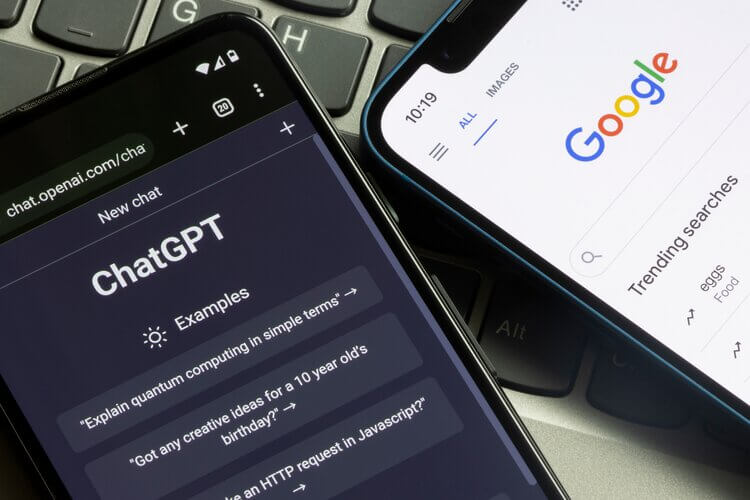Marketing

Benefits and Drawbacks of AI for Writing

31 October 2023 - 6 min read
The rise of artificial intelligence has revolutionised various aspects of our everyday lives. Whether that’s how we interact with brands through chatbots, personalised algorithms on our favourite social media platforms, or our trusty friend Alexa, AI has proven that it has a place in our lives and it’s here to stay.
Moreover, many organisations have also seen a great transformation since AI was first introduced, with claims that it can increase productivity and cut costs. However, the use of AI, especially as it pertains to education and the workplace, has sparked a heated controversy surrounding the risk of bias in content creation and copywriting. Concerns include the loss of human creativity, ethics, and most importantly, replacing the human workforce with AI tools and systems.
In this blog we explore the benefits, as well as the drawbacks of AI in writing, in order to avoid bias and inaccuracy in the information reported on.

What is AI Writing and How Does it Work?
AI-generated content refers to machine-written copy such as blogs, articles, product descriptions and other, often, marketing collateral, based on search queries and prompts typed into an AI tool. Take ChatGPT as an example. This AI bit serves as a platform where users can ask questions, give commands and ask the system for observations, to which ChatGPT can give both specific and broader answers.
What these AI softwares do is draw on existing information available on search engines and create unique content based on users’ commands and queries on different keywords, phrases and topics.
Using such systems and tools you can generate anything from extensive blog copies, to social media captions, to cooking recipes, it all depends on your input and command in the AI tool.
Nonetheless, AI systems used to create AI-generated content pull pre-existing information that’s already accessible on the internet, raising the concern of unoriginal content with the possibility of plagiarism. This is especially true for university students and online learners who employ the use of AI tools to write their assignments.

Concerns of AI-writing in Academia
This isn’t the first time AI found its way into the education sector, as Grammarly, another cloud-based writing assistant, has been widely used by students since its launch in 2009. Grammarly's purpose is to review spelling, grammar and punctuation in English written texts, while also detecting plagiarism and suggesting replacements to errors identified in the copy.
Contrastingly though, while tools such as Grammarly can assist and enhance the work of students, tools such as ChatGPT and ChatSonic, when used unethically, can cause major disruption in the education system. According to Thomas Lancaster, a computer scientist and expert on contract cheating at Imperial College London, new AI models can make a written document “incredibly tough to prove it has been written by a machine” as the “standard of writing is often good”.
In line with this, universities have been trying for years to combat essay mills from selling pre-written work to “students trying to cheat the system”, while many of those essay mills are now using AI tools. As a result, numerous universities have shared with the Observer that they are ready to expel any student caught using such software as a way to banish unoriginal (and likely plagiarised) work.
However, while using AI writing to complete an assignment and present it as your own work qualifies as academic misconduct, many argue that the responsible use of AI tools can in fact prove beneficial in supporting the learning journey.
CEO of academic integrity company Turnitin, Chris Caren stated that “when leveraged skilfully, we see AI potentially being used as a learning aid and intermediary tool that may even facilitate deeper intellectual inquiry”. He also added, “we all need to go back to basics and reimagine the true intent behind academic assessment: as a means of demonstrating knowledge acquisition”.

The Benefits of AI in Writing
1. Efficiency and Scalability
Perhaps the biggest benefit of AI is the speed in which it can create and deliver content, regardless of the subject’s level of complexity. For example, an AI tool can generate a full article in just a few minutes, but it would take a human much longer to do all the research for the article, then write it and finally review it for any spelling or grammar errors.
Considering the speed in which AI-generated content is created, this tool can be greatly beneficial for marketers looking to complete a backlog of content for a revised marketing plan or social media content calendar. This allows them to focus on more strategic aspects of their job such as forecasting marketing trends and analysing metrics.
Besides that, AI also has the ability to localise language for varied geographical locations, allowing the creation of personalised content for different sites, with different target markets and audience.
2. Cost-effectiveness
When it comes to hiring or freelancing quality content writers, it can often be very costly with some even charging hundreds of pounds for a single project, depending on the length, amount and expertise required for that content.
On the other hand, many AI writing tools can be accessed for free, while others can charge just under £100 for an annual subscription, which is a drastic difference to the human equivalent.
However, when it comes to human work, it’s obviously well-worth the extra investment for those seeking authority and expertise since it guarantees high-quality and well-researched content. But, for smaller companies and start-ups looking for quicker and simpler content to be created, AI-generated content may be better suited and a great place to start content creation from, especially when considering the low subscription fee.

3. Improves SEO
As we already know, AI content tools scan through thousands of online articles, websites and documents to extract information from as per your input. In fact when viewing such content, AI has the unique capability to identify and suggest to the content writer keywords that may improve search engine optimisation (SEO), which is perhaps one of the softwares’ biggest selling points.
This can add great value to a content writer’s work, especially if they’re unsure how to structure their content or how to effectively use those suggested keywords in their copy.
Through the utilisation of AI systems such as Byword for search queries, examples of optimised keyword clusters are generated, which the content writer can then use through their article in order to appear high in search result rankings. It’s important to note that this is only possible, and a benefit, when the rest of the suggested guidelines are followed, which refer to the copy being authoritative and written by a human.
4. Assist with Writer’s Block
Writer’s block is a very common issue many content creators face, as well as students, when it comes to how to start off their writing, or how to structure it. With the constant pressure to continuously create engaging and original content, it can be especially daunting when you have a deadline to meet and are expected to write about a topic you have little knowledge of.
AI systems such as HubSpot’s AI Content Writer can generate detailed outlines and key points you can include in your essay or article, helping you skip from the brain-storming part, straight to the writing part. Let’s be honest, who wouldn't love that? Even if you’re using AI as inspiration and not to write the article, you’re pretty much half way there already.

The Drawbacks of AI in Writing
1. Quality and Plagiarism Concerns
When it comes to content writing, a topic tends to consist of black and white areas, which can be covered by AI tools, but grey areas that tend to be subjective are lost when AI is employed.
Since AI pulls information from various different sources that have already been published online, in order to create the piece of content requested, users are often unaware that without the proper citation of these sources there’s high legal risk. An author can sue for plagiarism of their original work when it closely correlates to the AI-generated content if the source is not properly accredited for the information used.
Alternatively, if you’re using AI to create a full piece of content, make sure to review the copy before publishing it, rewording where necessary, and adding the right flow to connect the different pieces of information the AI tool drew, so that the content is both informative and authoritative. Not only that, but some of the information used may be coming from an unaccredited source.
2. Potential Content Devaluation from Algorithms
Last year, Google released its ‘helpful continent update’ in an effort to ensure that original content “written by people, for people” rank higher in search results than AI-generated content. Considering that AI content tools prioritise keywords and evaluate SEO results above all others without having a full understanding of the text, results end up not being informative to the reader at all.
Therefore, the ‘helpful content update’ states that search engine crawlers look for content created by humans when it comes to ranking results, which altogether provides a more cohesive and rewarding SEO practice. As a result, the update appears to punish AI-generated content, which is often SEO-heavy, by ranking it much lower than the purpose it was created for.
So, in order to avoid this, try and use AI tools to enhance your own creativity by using grammar-checking and content idea generating instead.

3. Lack of Creativity
It goes without saying that AI systems lack something that only humans can apply to content and writing and that is emotional intelligence. Emotional intelligence refers to the ability to recognise, interpret and describe how people feel. AI systems are not yet as sophisticated to be able to do that and the content they generate focuses on adding facts to the content outline.
Joe Matsushima, co-founder of branding design and photography studio Denizen Co. and the brain behind the viral social media video series ‘Tiny Hamster Eats Tiny Burrito’ stated that people typically share something on social media which they feel a connection to as an individual, explaining that “people want to share with others how they perceive the world and reflect their tastes and how they define themselves”.
Since AI relies on existing information to generate content, it doesn’t understand the user's intent behind the queries and lacks human behaviour, therefore the content is far less engaging than that created by humans.
4. Human Vetting is Still Required
Although AI tools are great for saving time when it comes to writing, it’s imperative that the content is proofread and edited before being published. That’s because AI’s lack of awareness omits offensive and inaccurate information being pulled through.
Likewise, AI tools also aren’t able to understand the meaning of adjectives, so when it comes to product descriptions for example there may be mistakes that need editing.
All in all, AI can be very beneficial for writing when used ethically, helping with content ideas, structuring content and even editing for any errors. However, since AI tools are a relatively new concept, it’s important to remember that the information they provide can be inaccurate with no real structure or high level of engagement, therefore, the content ultimately loses authority.
So instead of relying on AI tools to create the content for you, use it as inspiration and a way to enhance your own writing. And let’s be honest, your writing’s probably much more engaging and refined than that of any AI system.
Learn how to effectively employ AI by enhancing your marketing career with a 100% online CIM qualification.
Download Your Free CIM Course Guide
Get information on our CIM courses
Share this post
Labour Shortages – Why Upskilling Could Help You Land Your Next Job
The UK economy is in the grip of labour shortages. What does this mean for your career development and job opportunities? We took a closer look at the issue.
The 5 Best Alternatives to University
University isn't for everyone. Here are 5 of the best alternatives to university and higher education when it comes to getting a great career.
6 Important Body Language Signals Your Job interviewer Is Giving You
Paying attention to the body language of your interviewer can be useful in a job interview. Here are 6 of the most important body language signals to watch for.
















